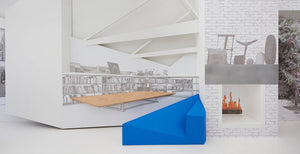Maarten Van Severen

Maarten Van Severen
Maarten Van Severen (1956 - 2005) was a talented Belgian furniture designer and interior architect, also a personal friend of CEO Hans Lensvelt. After Maarten Van Severen's passing in 2005, Lensvelt took on the role of producer for a significant part of Van Severen's collection. Van Severen's designs enjoy international recognition and appreciation, primarily due to the unique use of materials, impeccable quality, and meticulous finishing.
In 1986, Van Severen entered the world of furniture design and established an independent studio in Ghent. His creative focus was on researching fundamental furniture pieces such as chairs, tables, chaise longues, shelves, and cabinets. Through extensive exploration of form, material, and construction, Van Severen developed innovative solutions for these essential furniture categories.
In 1990, Van Severen began a close collaboration with Rem Koolhaas, expanding his focus to interior projects. This created an engaging synergy between his minimalist approach and Koolhaas' visionary design philosophy. This collaboration not only enriched Van Severen's work but also contributed to his growing influence in the field of interior design. The legacy of Maarten Van Severen lives on in his timeless and functional designs, leaving a lasting impression in the world of furniture art.

Maarten Van Severen x Lensvelt
The collection of Maarten van Severen had been officially launched in September 2013 in Lensvelt’s Headquarters at Herengracht 178, Amsterdam. Lensvelt included Maarten’s products after his death.
In 2014 Lensvelt, together with the architectural firm OMA, brought an exhibition to Salone del Mobile in Milan, in the Ventura Lambrate district. The exhibition was entirely devoted to the collection of Maarten Van Severen. The designer, who died in 2005, is increasingly recognized as one of the greatest designers of our time. In Italy it was the first time that Maarten Van Severen's complete collection was presented. The pieces of the collection were displayed in a 3D environment designed by OMA Architects, the architectural firm of Rem Koolhaas. They created a decor with graphic prints, 3D objects and meter-high photos, so that the visitor could imagined him/herself in Maarten van Severen’s former studio. In the past Lensvelt, OMA and Maarten Van Severen have collaborated on projects such as the Dutch embassy in Berlin and the Central Library in Seattle.

The installation by OMA_ for the launch of the Maarten Van Severen Collection at the Lensvelt Gallery
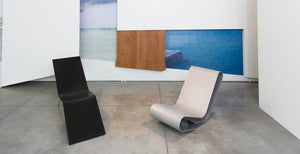
LC95_ lounge chair (r) and the the iconic lounge chair CHL95 of which there are only a limited number available.
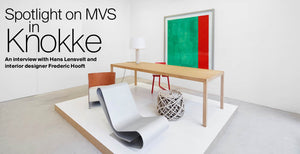
An interview_ with Hans Lensvelt and interior designer Frederic Hooft: about their love for furniture designer Maarten Van Severen and his timeless creations.
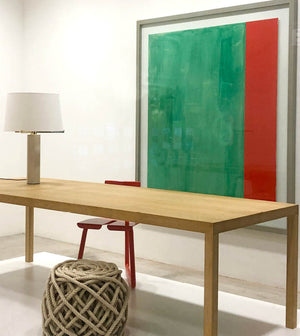
A Maarten Van Severen installation at the Brock Gallery, Knokke
His ingenious designs shine through in their pure simplicity. Moreover, they are functional and can be seen as sculpture or object at the same time. Hans Lensvelt and Flemish interior designer Frederic Hooft are unanimous in their love for the creations of the late top designer Maarten Van Severen. At De Brock Gallery in Knokke an installation of Van Severen's work composed by Hooft will be on display until the end of August.
He literally put the aluminium LC95 lounge chair, S88 bucket seat and T88W dining table - all produced by Lensvelt - on a pedestal. A podium full of eye-catchers as a tribute to the inventive Van Severen, who saw designing as brain gymnastics. The Fleming, who died of cancer in 2005 at the age of 48, sometimes spent years polishing a design, Lensvelt knows. His passion: achieving perfection. Like ultra-thin legs of a chair, a backrest as streamlined as a glacier or invisible connection techniques. Subdued and without superfluous elements.
This purity in combination with originality ensures that the designs of Van Severen are timeless and durable and belong to the world's top, according to Hooft. Van Severen did not limit himself to making furniture. He collaborated with Rem Koolhaas, among others, on the library in Seattle and the Dutch embassy in Berlin and he realised public spaces for the Van Abbemuseum in Eindhoven.
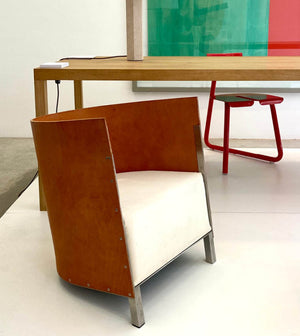
Frederic Hooft
Architect, occasional curator and interior designer Frederic Hooft first met Maarten Van Severen in 2000 when he visited his best friend, star chef Stefan Boxy. He had commissioned Van Severen to create a cooking studio in Deurle that suited his culinary style: pure, idiosyncratic and high-level.
To this day, Kitchen Pavilion Boxy's - with its austere glass fronts and view of the wild garden full of herbs and vegetables - is not only praised for its exquisite menus but also for its ditto design. With an indoor oak tree, enclosed by a glass tube, Van Severen came up with a real Instagram location even before the social medium existed.
Frederic Hooft: ,,From that time on, I have always kept Maarten Van Severen's architectural work and furniture in mind. I think his designs are among the most beautiful in the world. No matter how old they are, they remain contemporary and are by no means fashionable. And what is also very special: they fit in any interior. Sleek, classic, indoors and outdoors, it doesn't matter. They stand out. And they combine just as well with the interiors of Rem Koolhaas as with those of Axel Vervoordt. And that is incredibly special.
Frederic Hooft knows exactly why Van Severen's designs shine in so many different interiors. The magic lies in the simplicity, Maarten celebrates the essence, according to Hooft. The furniture is accurate in form and in proportion. Moreover, they are not only functional. In a classical environment, they stand out and transform into a sculpture, an object of art.
At the same time, this purity means that production for Lensvelt is particularly complex, says Hooft. More than precision work. “It is about fractions of millimetres when screwing together. Connections that must remain invisible. It involves extremely fine materials that have to be strong and able to take a certain weight. It's about perfection.”
In De Brock Gallery at the Belgian seaside resort of Knokke he has put together an installation by Van Severen. “At the request of owner Patrick De Brock I contrasted several of Maarten’s furniture pieces with works of art by the Germans Günther Förg and Imi Knoebel and the Brit Jason Martin, that also works together. Maarten's furniture is so good, it works everywhere''.
Hans Lensvelt
For Hans Lensvelt, Maarten Van Severen is much more than a top designer and colleague. In fact, he calls him a friend. Despite Van Severen's struggle with life, the artist inspired Lensvelt, providing ornaments in his head.
Lensvelt: “Maarten taught me to look at things differently and never to give up. He taught me to investigate matters and to keep investigating. Also: to not make any concessions.” After more than 30 years as CEO in which he experienced turbulent and beautiful times, Hans Lensvelt knows for sure: "Maarten Van Severen was one of the people who changed my life.” A modest, shy man with an enormous creative impact.
Lensvelt first met the Flemish multi-talent in the late 1990s in Bordeaux. At that time, Van Severen's name had been mentioned alongside that of Joep van Lieshout during conversations with colleagues about up-and-coming artists and designers who mattered. “At that time, I also had contacts with the business leader of OMA: Jeroen Thomas. He was responsible for Maison à Bordeaux by client Jean-François Lemoine and invited me to visit the building site. Maarten had designed the groundbreaking interior: he came up with an aluminium floor measuring 200 square metres. When I saw him, he was sanding it with his son. We didn't speak, we just nodded.”
Right after the turn of the millennium, OMA received the commission for the library in Seattle. And as in Bordeaux, Maarten Van Severen was again responsible for the interior. Because the building lies on a faultline where earthquakes take place, OMA came up with the bright idea of hanging the bookcases from the ceiling. Chris van Duijn, architect of the project, asked Lensvelt whether he would be interested in co-developing this hanging system - consisting of ca. 35,000 metres of shelves.
The first personal consultation about this topic between Maarten Van Severen, Chris van Duijn and Hans Lensvelt was to take place in Milan during the Salone del Mobile. Lensvelt: “I was looking forward to that meeting in a coffee shop on Piazza San Babila. Chris and I waited and waited, but no Maarten. More often than not, he would not show up at all or would show up way too late. That never stood in the way of our friendship. It was just part of it.”
Lensvelt points out the enormous contrast between Van Severen's work ethic and his attitude in his private life. There he struggled with his own demons. His addictions to alcohol and drugs, which regularly led to his physical and mental derailment, can also be seen in Moon Blaisse's film portrait Addicted to Every Possibility. Lensvelt: “Such a contrast with his work. In his work, he was so disciplined, without concessions. It had to be exactly as Maarten had it in his head. He kept researching and researching, never gave up.”
For weeks and months, they worked shoulder to shoulder on the hanging system for the Seattle library. With one goal: a uniquely innovative system, a clean design. In the end, the hanging library shelve was not applied, despite earlier verbal assurances. “I remember that moment very well. Maarten, my whole team and I were waiting until late at night because of the time difference with Seattle. After the decision was made, we celebrated exuberantly." Eventually, the library board vetoed that decision. A standard system was used, which may have been the salvation for Lensvelt Contract BV: the original project would have resulted in enormous losses.
Seventeen years after the death of Maarten Van Severen, who was suffering from cancer, Hans Lensvelt still gets emotional. He remembers his frail figure at the last meeting. And the intimate funeral that the family invited him to. “There was a small group of people. 30 family members, 30 friends. Xavier de Geyter was there. Chris van Duijn was there. It was a great honour for me to be there. But I found it even more sad to see that urn there in his studio, with the remains of this special person and this so talented designer in it''.
In October 2012 Lensvelt exhibited at Interieur in Kortrijk, one of the most important design fairs in Northwest Europe. There, Lensvelt ran into Marij De Brabandere, widow of Maarten Van Severen, again after a long time. She shares that the interior design company Top Mouton, renowned for decades in the design sector and producer of Maarten Van Severen's work, has gone bankrupt. To her question whether Lensvelt would like to take over the production, he replied: ,,Marij I think that is a great honour. And an obligation to my friend Maarten Van Severen. I will do that. Of course."
Maarten Van Severen's products look simple, but in the end they are very difficult to produce. It therefore took more than a year to set up production with various suppliers. But by the end of 2013, the time had come. An important part of the collection could be produced and delivered. It was time for an introduction. “I chose to combine this with the opening of the Lensvelt building at Herengracht 178 in Amsterdam. This was during the Inside Design organised by Elle Decoration. I showed Maarten's products at the most prominent place in the building: in the gallery, in a white space.”
It was decided that in 2014 Maarten's products would also be shown in Milan during the Salone del Mobile. A very special moment during this Salone was the visit of Maarten Van Severen's widow: Marij De Brabandere with her new partner, the Frenchman Jim Hordé. Jim and Marij took a seat on the Charisse lounge CHL 95. These were the third and fourth chaise lounges. The number one is owned by Marij. The number two is part of the permanent exhibition at the Centre Pompidou.''
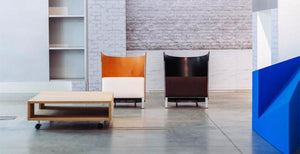
The installation was in concept an exact copy of the installation at the Lensvelt Gallery.
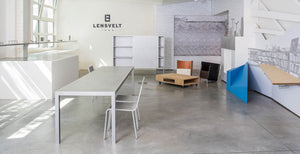
The installation was in concept an exact copy of the installation at the Lensvelt Gallery.
